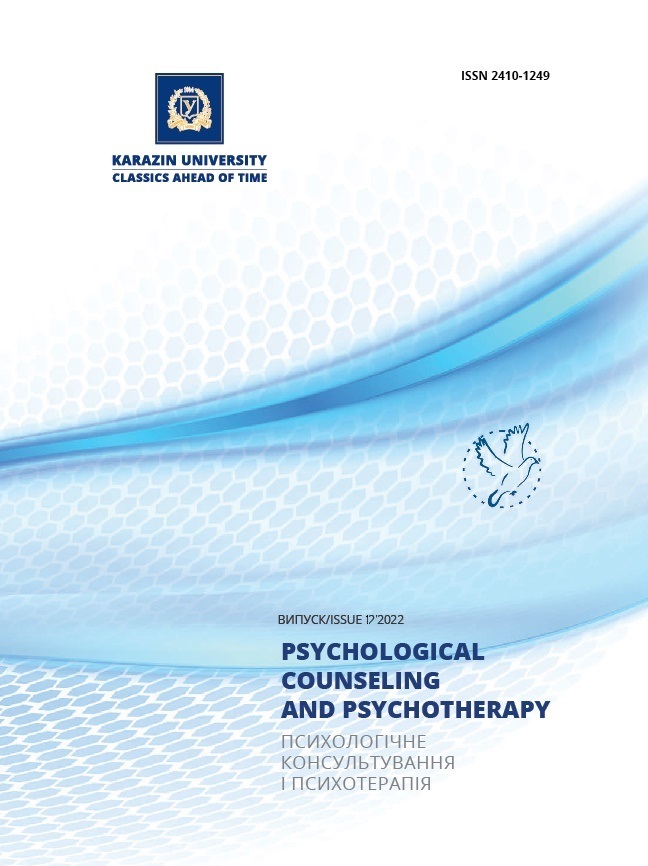Metaphor Technique: Psychotherapeutic Casuistics
Abstract
The technique of therapeutic metaphor is largely used in psychotherapeutic practice as a "system of empirical techniques", and has no scientific basis. The status of "tool", "method" is insufficient for the interpretation of psychotherapeutic metaphor. Metaphor is a complex entity that operates at different levels of personal organization. It works not only as an oriental metaphor, as a fairy tale, which due to the fascinating effect deepens the penetration of "correct" content in the conscious and subconscious of the client. An important feature of the metaphor is not that it "advises" the client, provides a correct understanding of the situation, problems and solutions. This understanding of metaphor makes it gently directive, a kind of veiled advice. Metaphor allows a person to enter all layers of their own existence, including somatic organization, to transform their own experience. Therefore, the therapeutic metaphor is an experiential approach to solving their own problems. The article presents work with a client who had very unarticulated complaints. The work was devoted to the realization of the metaphor of life, which had manifestations at all levels of the early emotional scheme - cognitive, emotional, somatic, early memories and motivation. The original metaphor of life "humble" vs "free" was transformed into a metaphor of "web" vs "sea". In the second healthy metaphor, the connotation of the poles changes and a new somatic structure is formed. The following conclusions were made: 1) the client's life really corresponds to some metaphor, it is built for it; 2) such a metaphor is either not realized at all by the client, or partially; 3) the therapist helps the client to understand the metaphor of life, which has a somatic (vegetative-sensory) status - emotions-in-the-body and thoughts-in-the-body (in this case, the somatic structure of the lifestyle "humble" - belching, sore throat, bloated stomach , compressed stomach, poured like foot pads, etc.); 4) it is necessary to determine the negative life consequences of such a metaphor; 5) as a rule, the metaphor carries polarity ("humble" vs "free"). Each pole has certain connotative meanings that should be articulated; 6) it is necessary to determine the direction of flow of internal dynamic forces in this case, the main flow is realized in the direction of "free" vs "humbly." Healthy flow should be carried out in the opposite direction; 7) you need to offer the client a new metaphor, with other poles that have the opposite connotative load ("humble" vs "web"; "free" vs "sea"). Such a transformation of life metaphor is aimed at forming new, healthy somatic and emotional roots ("sea" - joy, pleasure, relaxation, freedom, easy breathing, free, light legs, etc.); 8) the new metaphor should be perceived by the client as one that corresponds to their perceptual field. The transformation of life metaphors predisposes to lifestyle transformation.
Downloads
References
Metaphor in psychotherapy, https://works.doklad.ru/view/6dIyWwY7144.html (in Russian)
Trunov, D. The use of metaphors in psychotherapeutic work, (in Russian) http://psyterra.narod.ru/ind_prof13.htm
Karvasarskiy, B. D. (2000). Psychotherapeutic Encyclopedia. SPb : Piter. (in Russian)
Gordon, D. (1995). Therapeutic metaphors. Moscow: White Rabbit (in Russian)
Pazeshkian, N. (2014). The Merchant and the Parrot: Oriental Stories and Psychotherapy. M.: Academic prospectus. (in Russian)
Estes, K. (2016).Running with the wolves. Female archetype in myths and legends. Мoscow : Sophia. (in Russian)
Rodzhers, K. A look at psychotherapy. The formation of man / Common. ed. and foreword. Isenina E.I. Per. from English. – Moscow : Progress Publishing Group, Univers, 1994. – p. 480. (in Russian)








